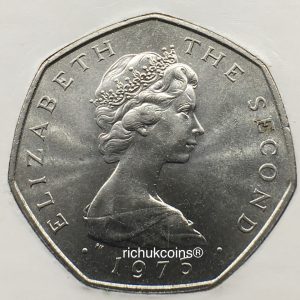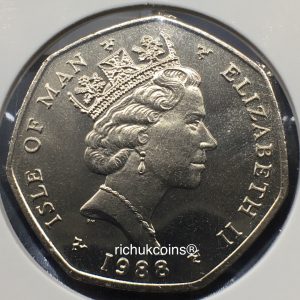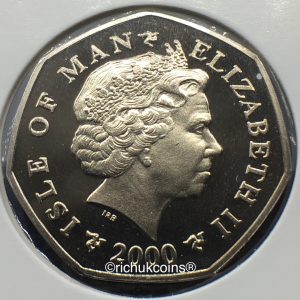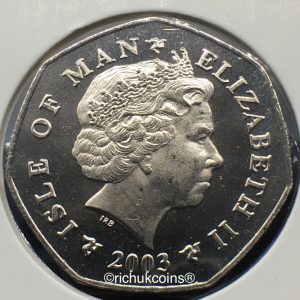Published on
Last Updated on:
In this article, you are going to see two parts, named Part I and Part II. In Part I, it is a part to illustrate decimal coin by set, and by theme in Part II.
Part I (by set)
It is very interesting to talk about this topic. Because the 1971 IOM coin collection sets were struck at the Royal Mint, and the 1972 to 1975 sets then were struck at the Pobjoy Mint. But, Tynwald, the IOM government entity, had to require its own consistency on IOM coinage at the beginning of decimal coinage system. Therefore, the 1972 to 1974 sets had to be struck in 1975. Remember that IOM Year coin collection set had the specimen finish (SF) set, Brilliant Uncirculated (BU) finish set and Proof (PF) finish set in 1971, what sets would possibly be in 1975. The answer is SF (or BU) sets only. In order to illustrate each set, 50p coin from each set are used to show the difference among them (see pictures below). With regard to 1971 coin sets, the SF set was presented in plastic holder and the PF set in a white square box both made by the Royal Mint. Interestingly, the BU sets was all stored in Perspex folder made by the Pobjoy Mint when I sourced them.
- 1971 Viking 50p Specimen Finish (SF) coin from the Royal Mint folder set
- 1971 Viking 50p Brilliant Uncirculated (BU) from the Royal Mint BU set
- 1971 Viking 50p Proof (PF) coin from the Royal Mint proof set








- 1972 50p Brilliant Uncirculated (BU) coin from original the Pobjoy Mint BU set




- 1973 50p Brilliant Uncirculated (BU) coin from original the Pobjoy Mint BU set




- 1974 50p Brilliant Uncirculated (BU) coin from original the Pobjoy Mint BU set




- 1975 Specimen Finish (SF) set




You have seen year coin collection sets above from 1971 to 1975. It is worth mentioning that the Pobjoy mint did really good a start for Tynwald especially over the period between the two mints in transit. They smoothly shifted the PF sets of 1971 to 1974 and the BU sets of 1972 to 1975. Probably, it is only just a sign for the number 4 related circle. The ball is in your hands what will you do?
Part II (by theme)
Here we go, …
1975 Viking boat in full-sail 50p coin (Start, PM)


(Note: The reverse was created by the Royal Mint. This coin below it belongs to 1972/1973/1974 theme. Therefore, BU kind — (1972/73/74/75) & PF kind — (1971/72/73/74).)
1976 IOM Viking longboat 50p coin with Odin’s Raven in 1976/1977/1978/1979(t)


1979 IOM Viking Millennium Voyage 50p coin, associated with A/B/C/D sequence, in 1979


(Note: Tynwald Millennium Voyage and Royal Visit IOM events were held in July simultaneously.)
1980 IOM Viking boat in full-sail 50p coin in 1980aa/81aa/82ac/83aa


1984 IOM Viking boat in shield 50p coin in 1984aa/85aa/86aa/87aa


1988 IOM Personal Computer 50p coin in 1988aa/89aa/90aa/91aa & 1992aa/93aa/94aa/95aa


1996 IOM T.T.-related 50p coin in 1996aa (large)/97aa (large)/98aa/99aa


2000 IOM Christianity 50p coin in 2000aa/01aa/02aa/03aa


2004 IOM Miller’s Tower 50p coin in 2004aa/05aa/06aa/07aa & 2008aa/09aa/10aa/11aa & 2012aa/13aa/14aa/15aa & 2016aa (The End, PM)


The 4th portrait and the 5th portrait of Q E II and the Pobjoy own portrait in transit in 2015 from the perspectives of Tynwald and the Pobjoy Mint. In order to know more about Q E II portraits in details, visit Royal Mint website [adapted on 23/08/2018].
(Note: The Pobjoy own portrait was only used on circulating commemorative coins (i.e., IOM T.T. and Xmas).)




Note for this part: Die letters may vary from coins to coins above over the period of 1979 to 2016. However, we use AA/aa version instead here.
The new mint and the new coin, new future?
2017 IOM Ram 50p coin in 2017 by the Tower Mint


However, story is about to be continued…
#The End





